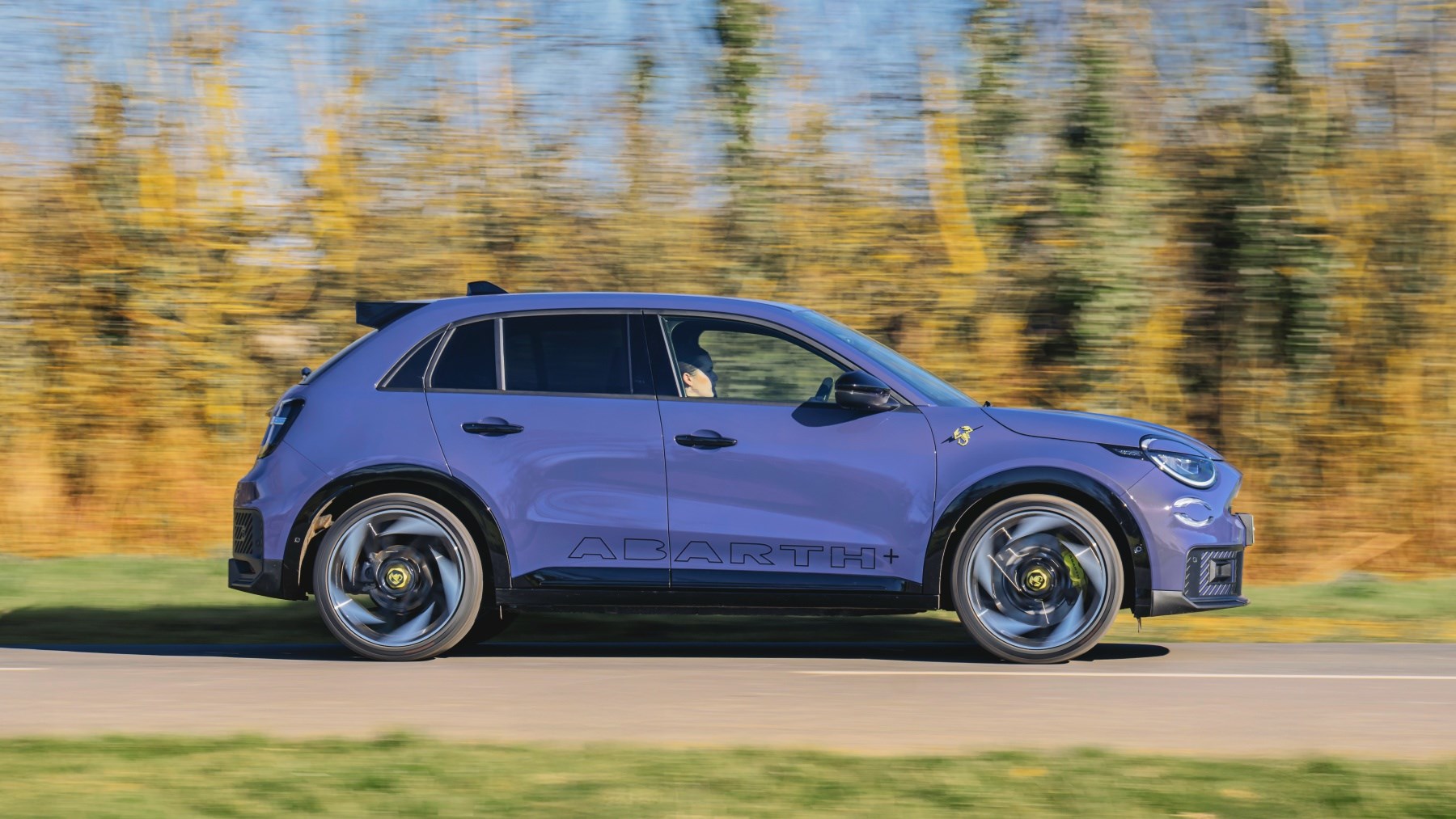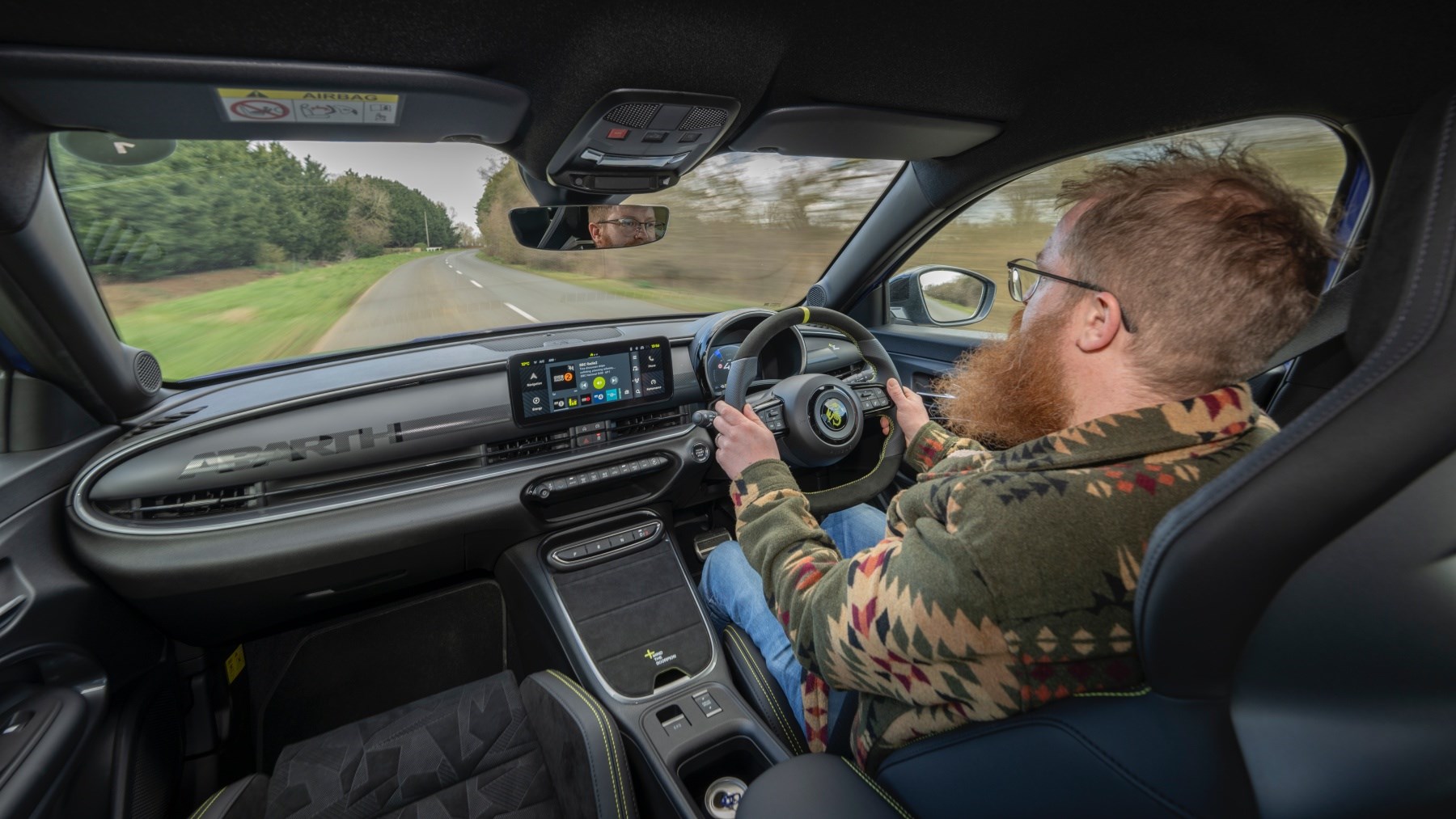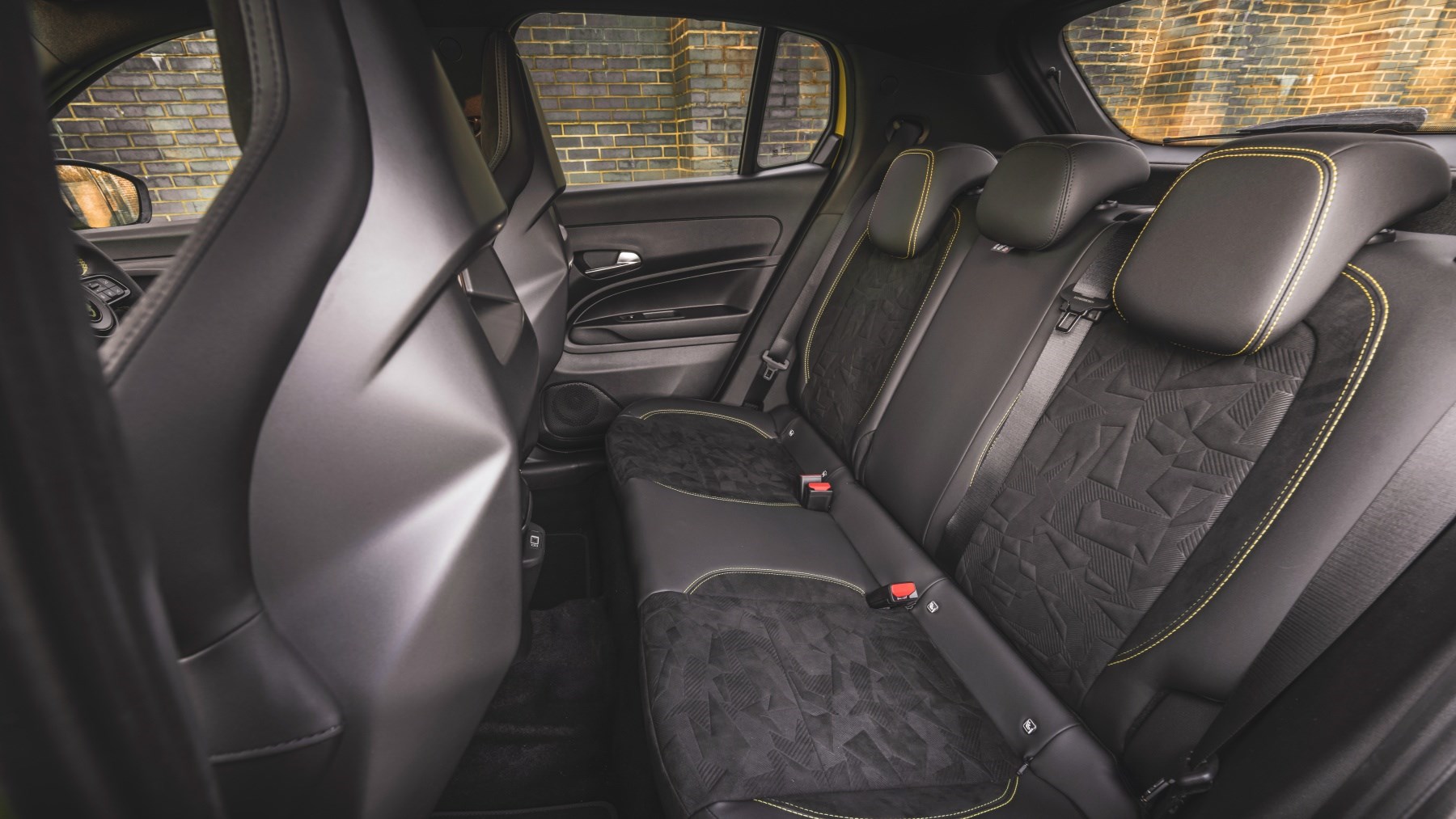► Abarth’s EV pocket rocket driven in the UK
► 237bhp or 278bhp, limited-slip diff for both
► Seriously fun, if not for long
We’ve already been impressed by the Abarth 600e on road and track in Italy, so now it’s time to see how it deals with the UK’s particular brand of patchwork roads. In case you missed it, Abarth turns the Fiat flavoured version of the Stellantis small SUV into an electric hot hatch designed to sit above the Abarth 500e with more space and performance. Like its non-identical twin the Alfa Romeo Junior Veloce, it gets a massive power boost over lesser 600es but the Abarth gets a more aggressive chassis setup.
It’ll come in two trims, including one with a Junior Veloce matching 278bhp, and both feature the same clever Torsen limited-slip differential as Milan’s hot hatch. But just how different is Abarth’s take, and can something so fun really be teased out of a platform that’s produced so many mediocre cars since its introduction?
To find out just how good it is, we drove both versions of the Abarth on Stellantis’ Balocco proving ground, and the roads nearby. We followed that up with a drive of the 278bhp Scorpionissma on some challenging UK B roads and on a kart track.

At a glance
Pros: Feels like a proper hot hatch, rapid acceleration, likeable character
Cons: Poor range, base model interior feels bare
What’s new?
The Abarth 600e is an all-new car, but it’s essentially just a harder, more extreme version of the Fiat 600e we’ve already seen. On the outside, this 600e gets a blockier, more aggressive front end, with Abarth’s designers drawing inspiration from the 850 TC. In person it’s surprisingly well-proportioned and looks a little like a touring car. Walk around the back and there’s huge rear wing along with a black rear apron and diffuser, but sadly the somewhat sleepy-looking headlights remain.

It measures 4187mm, but the track has been stretched an additional 30mm wider at the front and 25mm at the rear. The whole thing also sits on 20-inch alloy-wheels.
The base level 600e comes in Acid Green, Antidote White, Shock Orange, and Venom Black. A more powerful but limited-edition Scorpionissima trim is available in Acid Green and the exclusive Hypnotic Purple. Only 1949 models worldwide will be made initially, though it’s likely a top-spec version with the more powerful motor and nicer interior will exist in some form once Scorpionissma is sold out.
What are the specs?
Abarth is offering in the 600e in two distinct flavours: a ‘standard’ and Scorpionissima. Both use the same 54 kWh battery (51 kWh useable), produce the same 254lb ft of torque and have identical top speeds of 124mph. However, where the standard motor is able to produce 237bhp, the limited-edition Scorpionissima puts out a Veloce-matching 278bhp.

That translates to a 0-62mph sprint of 6.2 seconds for the standard car and 5.9 seconds (5.85 as Abarth would point out) for the Scorpionissima. The extra performance in both has also necessitated an upgraded heat rejection system for the lithium-ion battery and control electronics. Abarth says it uses Formula E tech – which is a trend for this car.
As for range and charging? A 100kW fast-charge from 20-80% takes 27 minutes in both cars, while the range on performance tyres is a relatively low 207 miles for both.
Both models get a raft of chassis improvements: The suspension is 41% firmer, and engineers have added a new rear anti-roll bar to improve stiffness over the standard 600e by 140%. The brakes have been upgraded as well, so you’ll now find Alcon four-piston 380mm brakes on the front axle. The steering has been tuned to be more direct. Plus, to create a purer feel on the left pedal, the Abarth doesn’t combine the friction brakes with regen on the faster modes. All that necessitates a pair of supportive Sabelt seats that clamp you firmly in place

The biggest upgrade, however, comes with a JTEKT Torsen mechanical limited slip differential, identical to the one in the Alfa Romeo Junior Veloce. Fitted to both the 237bhp and 278bhp Abarths, it provides extra torque on the outside wheel for improved handling and traction when turning. JTEKT states its locking-effect setup rates at 36% during acceleration and 34% during braking.
This is the second Stellantis EV we’ve seen the LSD appear in, and we expect at least one more; CAR understands we’ll see the same tech in an upcoming Lancia Ypsilon HF. The thought of this powertrain in an even smaller, lighter, and lower hatchback has us rubbing our hands with glee.
The Abarth 600e also gets high-spec tyres that feature a smidge of crossover from Formula E. Made from a softer compound on the outer edge and a harder one in the middle, they attempt to balance efficiency and grip. They’re also around 20% quieter than the tyres on the normal 600e.
How does it drive?

Before we even get into the chassis dynamics, it’s worth talking about the power of the 600e. On rippling Fenland B roads the top spec’s 278bhp, 5.85 second 0-62mph sprint feels faster than you’d expect, with little tugs of torque steer as the power gets channeled to where it’s most effective. Think Civic Type R or Focus ST pace but delivered in one linear shove with far sharper throttle response, and you’re about there.
Before we got in the car in both Italy and the UK, Abarth’s engineers were keen state the 600e only uses the hydraulic system for braking in Track mode, and not a mixture of regen and discs. After a few corners it’s easy to see why. The braking performance is strong, but so much more predictable and easier to modulate than in many other EVs. Braking just feels purer, and it means we can trail brake into corners with confidence. However, without regen, expect range to tumble even faster, and on a tight kart track the pedal started to go long after only four laps.
The steering builds confidence and plumbs you right into the action. We prefer the weight of the sportier modes for enthusiastic driving and found the rack to be perfectly paced without any artificial ramp up in ratio. Some sense of the front tyres’ activity can be felt through the Alcantara steering wheel rim, giving you the confidence to really attack a bend. Pin the brakes on the way in and you’ll even feel the tail rotate slightly to get the nose tucked in even tighter. This is proper hot hatch stuff, albeit with an ever present electronic eye to stop anything getting too wayward.
Mid-corner, the stiffness of the chassis comes to the fore, as does that lowered ride height and stiffened suspension. There’s just far less movement than you’d expect, given the car’s 1640kg kerb weight and plenty of grip from the standard performance-oriented tyre. A more efficient run-flat option is also available, but we’ve not sampled it yet.

Yanking you out of the corner and adding further sparkle is the trick LSD on the front axle. With the nose aimed directly at the apex by the keen turn-in, you can mash the throttle and feel the diff pulling the 600e onto your desired course rather than washing wide. It’s beautifully tuned, proving strong enough to get the job done and remind you it’s there through the wheel, without it becoming a tiresome torque steer wrestling match.
Any worries about the Abarth 600e being too stiff for UK roads are only part fulfilled. Yes, the spring rates are high so your acutely aware of the road’s surface as it passes beneath the tyres, but the damping saves it. Bumps are dealt with on the first hit and there’s no crashiness or brittleness to the ride. If you could live with a Puma ST, you could live with this.

And what about the difference between the top spec and the standard car? In practice, it was hard to really notice the extra 40bhp, especially on the road. The chassis and LSD are shared on both, and it’s those components that really bring the entertainment.
What about the interior?
If you’ve been in the Jeep Avenger or the Alfa Romeo Junior – or any other e-CMP-based product – the interior here will seem quite familiar. However, the Abarth strikes a good mixture of premium and sporty, despite the relatively cheap plastics used. It’s dark and svelte and there are nice touches such as aluminium pedal covers. The only places you really notice cost-cutting are on the door cards, which are just as disappointing as the Junior.
Aside from that, you’re greeted by a 10.25-inch infotainment screen and cockpit dials that stretch over the Alcantara-clad wheel. Most of the cabin is dominated by an oval-shape that extends across the width of the interior whilst incorporating the air vents. It’ll almost certainly get covered in fingerprints, but it does the job and gives the Abarth a different feel to other Stellantis products. It does share most of those other small SUVs tight rear legroom and average boot, though.
The interior differs slightly depending on the trim you go for; the Scorpionissima uses firmer Sabelt sports seats that lock you in with four types of high-density foam, and there are other bits as standard such as wireless charging, floor mats and a cubby hole cover. The standard car’s seats work out just fine but there’s a lot missing compared to the top-spec car. The Scorpionissima also separates itself with a faux-engine noise you can turn off if needed.
As you’d expect, you get the usual tech such as adaptive cruise control, USB-C and -A ports, as well as a rear parking aid, keyless start and Android Auto and Apple CarPlay functionality. The Scorpionissima comes with other extra bits as standard such as lane positioning and traffic jam assist. Finally, an optional safety pack includes driver alertness monitoring, along with an AEB system, lane departure warning and six airbags.
Before you buy
The range-topping Scorpionissima model gets exclusive ‘Hypnotic Purple’ paint, in addition the power hike and extra kit listed above. It’s limited to just 1949 units and will cost less than £40k. That’s less than the Junior Veloce which attracts the luxury car tax.

Move down and prices for the regular Abarth 600e kick off at £36,975 and you still get 20-inch wheels and all the good chassis tech. That’s halfway between the bog-standard 154bhp Fiat 600e and the Scorpionissima. Interestingly, it’s only Abarth that offers a 237bhp powertrain on the e-CMP platform so far; there’s a 154bhp and 278bhp Alfa – but nothing in the middle
Verdict
Make no mistake, this is a proper hot hatch that just so happens to be electric. Even with 237bhp, it provides just enough performance to make driving on more demanding roads thoroughly entertaining. Trick diff aside the 600e’s chassis helps you get to the limit in an accessible and engaging way. Throw in the LSD and it gets an extra layer of performance and fun.
Problems? The ride is hard but not harsh, so that’s no dealbreaker, and we’d live with some of the painfully cheap-looking interior plastics. The range is more of a problem as it’s significantly down on the Mini Cooper SE and Alpine A290, and this is a car that’s going to make you drive quickly because it’s so fun. Expect sub-150 miles per charge in the real world.
If you don’t mind plenty of charging, which one should you get? The standard car offers enough straight-line punch and the same capable chassis for a good amount less money, but its interior has been stripped back to make that happen. We’d spend the extra on Scorpionissma for the extra niceties and a purple that pops in the sun, and consider the extra power a bonus.
(Specs are for non-limited 237bhp model)